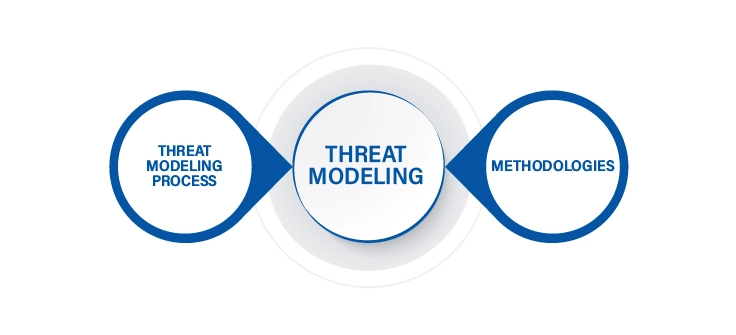
As there is an increase in the number of hacking incidents and security threats, many organizations have made cybersecurity their priority. They only brought security threats to their attention when they risked the business’s reputation, remediation costs, and loss of business.
Our lives, both corporate and personal, have shifted to the online world, and we have so much at stake. This enabled us to take up cybersecurity and digital security. Cybersecurity professionals are working frontline to protect the data, assets, and identity by deploying a load of defenses and countermeasures to keep the data and sensitive information safe.
Threat modeling is an easy and cost-effective way to enable security in the design phase before any code is written. Its primary intention is to perform a proactive cybersecurity threat assessment. You can have your threat modeling process, but to do so, we shall elaborate on the term Threat Modeling, its process, and methodologies.
Read Also: Responsibilities of a Cyber Security Professional
Threat modeling is a proactive strategy for evaluating risks. It is a process of identifying and prioritizing potential threats to protect valuable data and sensitive information. In other terms, it is a method of optimizing network security by locating vulnerabilities, identifying objectives, and developing countermeasures to prevent or reduce the effects of cyber-attacks against the system.
One of the apparent benefits of threat modeling is the improved application security posture. Organizations often identify application vulnerabilities in the final stages of software development. With threat modeling, these threats are resolved through security controls, thus forcing them to be implemented in the design phase. This injects security with the design principles into the application’s architecture and reduces threats and vulnerabilities before the codes are written. It reduces the effects of a cyberattack and reduces remediation costs.
Read Also: Top Cyber Security Jobs in 2023
Cybercrime is taking place every day, all day long. There is no stopping it but, all we can do is protect our networks and computer systems from these malicious attacks. To fight this, sound threat modeling design for intense security is essential. It can help the security teams to understand where security is lacking, how it is vulnerable and help them make an informed decision.
Read Also: Cybersecurity Skills for 2023
While performing the threat modeling process, several aspects and processes should be included. It works by identifying the threats that have caused harm to the application or the computer system. It enforces analyzing the software architecture, enabling a deeper understanding of essential aspects of the system.
Threat modeling is the process of taking a broader look at assessing the organization’s digital assets, identifying the weak spots, determining the threats, and coming up with protection plans. Generally, the developers perform the threat modeling process by asking these four questions.
Read Also: Best Cyber Security Certifications
To understand each of the questions specifically, you need to have a clearer understanding of the components to address the threats.
Threat intelligence is an area of collecting information about types of threats, detection of the mechanism and tools, identifying the motivation of malicious hackers, and the vulnerabilities they might exploit. They enforce it to enrich the understanding of possible threats and inform responses.
Mitigation capabilities are referred to as the power of the tools and technologies used to protect, detect, and respond to a type of threat. Assessing the current stuff will help you determine whether you need additional resources to mitigate a threat.
Risk assessment tools are necessary to understand the current status of their security systems. It develops plans to address vulnerabilities with the vigorous testing of systems and solutions.
Following the paths of potential threats defines the process of threat mapping. It is used to expect the movement of attackers so that defenses and resources need to be effectively layered or applied.
Raad More: How to Become a Cyber Security Professional?
The varying structured approaches for threat modeling are called methodologies. With the increasing number of cyber-attacks, there are various methods through which cybercrime is fought. The suitable model depends on the type of threat you are facing. Following are a few methodologies that are used for threat modeling.
1.STRIDE
STRIDE is the threat model created in the late 90s by Microsoft engineers. It is meant to guide threat discovery in a system. STRIDE stands for the six categories of threats it covers.
2.PASTA
PASTA stands for Process for Attack Simulation and Threat Analysis, a seven-step attacker-centric methodology. It is designed to focus on aligning technical security requirements with business activities. It offers a dynamic threat identification, enumeration, and scoring process. The steps of the PASTA model are:
3.DREAD
DREAD is a threat modeling method used to rank and assess security risks in 5 categories.
4.VAST
VAST stands for Visual, Agile, and Simple Threat modeling. It provides unique actional outputs for the specific needs of various stakeholders. It is a modeling platform that distinguishes between the application and operational threat models.
5.Trike
Trike is an open-source tool that focuses on threat models as risk management tools. It operates from a defensive viewpoint, where threats are identified and given risk values.
6.Attack trees
Attack trees are conceptual diagrams that display how they can attack the assets. It consists of root nodes with possible paths as different branches with child nodes. It is one of the oldest threat modeling techniques, which is now used by combining PASTA, CVSS, and STRIDE.
7.Common Vulnerability Scoring System (CVSS)
The CVSS system is designed to access threats, identify effects, and assign a numerical score to understand their intensity. This representation helps organizations easily understand the depth of impact and prioritize unique vulnerability management processes.
8.OCTAVE
The OCTAVE, which stands for Operational Critical Threat, Asset, and Vulnerability Evaluation, is a risk-based threat modeling methodology. It focuses only on assessing organizational risks and does not address technological risks. It comprises three phases:
Read Also: Why Cybersecurity Is Important Now More Than Ever
The vast number of malicious attacks requires adequate methodologies to prevent and mitigate their effect on the network and system. Consider having various threat models interconnected with one another. Keeping in mind is that a threat model is a live document and needs regular updates. There are several ways to assess security threats, which is because the threats will continue no matter what, as hackers keep developing alternative ways to conduct their malicious activities.
Read Also : The Future of Cybersecurity
Explore the Cyber Security Training Courses Offered By Edoxi Training Institute in various countries and locations in the Middle East.
| Country | UAE | Oman | Qatar |
| Course Location | Dubai | Muscat | Doha |

SENIOR TRAINER: NETWORKING AND PROGRAMMING
Jon Baleva is an IT professional with 20 years of experience in programming and networking. He is an expert in Python & IT Security domains as well as in Operating Systems (OS). He has trained professionals and students in IT Programming courses, Microsoft Azure, Linux & MAC OS. He is also a writer who writes on tech-related topics for various tech magazines in Philippine. He is now an IT Trainer with Edoxi Training Institute, Dubai.
